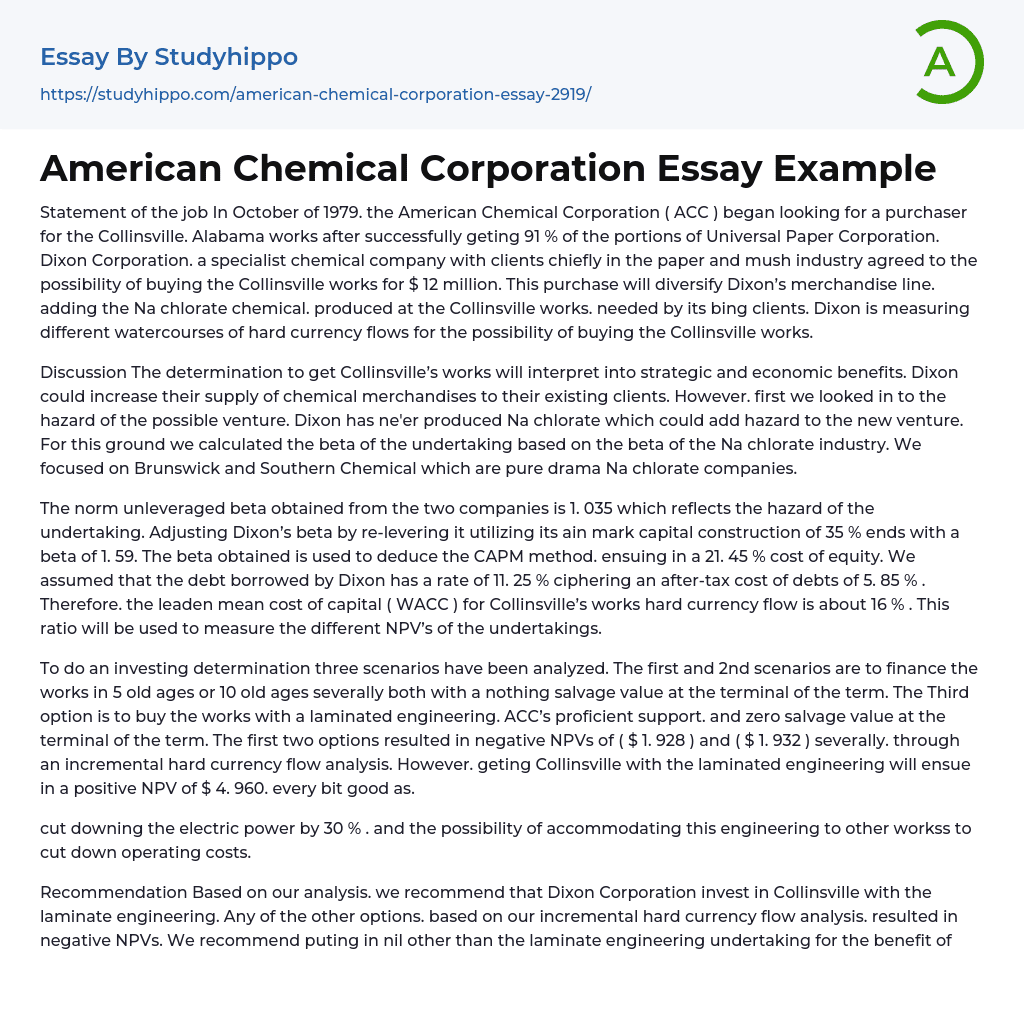In October of 1979, the American Chemical Corporation (ACC) sought a buyer for its Collinsville, Alabama works after obtaining 91% of the shares of Universal Paper Corporation. Dixon Corporation, a specialist chemical company catering mainly to the paper and mush industry, expressed interest in purchasing the Collinsville works for $12 million to diversify their product line. This acquisition would include Na chlorate chemical production, required by Dixon's existing clients. Dixon is evaluating various cash flow streams to determine its potential for acquiring Collinsville. The acquisition could provide Dixon with strategic and economic benefits by expanding its chemical products to current clients. However, before proceeding, Dixon assessed the risks associated with purchasing Collinsville, as they have not previously produced Na chlorate. To mitigate risk, they calculated
...the beta of the undertaking based on the beta of the Na chlorate industry using Brunswick and Southern Chemical companies as benchmarks, resulting in a beta of 1.59 by re-leveraging Dixon's beta, using its own target capital structure of 35%. This beta was used in conjunction with the CAPM method, yielding a 21...Assuming a 11.25% interest rate on the debt borrowed by Dixon, the after-tax cost of debts is calculated to be 5.85%, resulting in a weighted average cost of capital (WACC) of approximately 16% for Collinsville's cash flow. This percentage will be used to evaluate the NPV of the projects. Three investment scenarios have been analyzed: financing the works in 5 or 10 years respectively, both with no salvage value at the end of the term; or purchasing the works with laminated technology, ACC's technical support, and zero salvage value at the end of the term. The first tw
options resulted in negative NPVs, but investing in Collinsville with laminated technology yielded a positive NPV of $4.960, a 30% reduction in electric power, and potential cost savings for other plants. Based on this analysis, Dixon Corporation should only invest in the laminated technology project for the benefit of shareholders.Dixon needs to prepare for a potential failure of the laminate engineering during an acquisition, to protect itself. Additionally, ACC should compensate Dixon for any associated installation costs. The acquisition will provide benefits to stockholders and enhance the provision of chemical products to current customers.
- Company essays
- General Motors essays
- Bmw essays
- Ford Motor Company essays
- Honda essays
- Toyota essays
- Volkswagen essays
- Amazon essays
- Apple essays
- Enron essays
- Tesco essays
- Ibm essays
- Costco essays
- Kellogg essays
- Ikea essays
- Iphone essays
- Supermarket essays
- Gap essays
- Walmart essays
- Adidas essays
- Red Bull essays
- Pepsi essays
- Coca-Cola essays
- Burger King essays
- Kfc essays
- Mcdonald's essays
- Key essays
- British Airways essays
- Nokia essays
- Facebook essays
- Myspace essays
- Twitter essays
- Google essays
- Microsoft essays
- Ryanair essays
- Southwest Airlines essays
- Johnson and Johnson essays
- Sony essays
- Ebay essays
- Pepsico essays
- Starbucks essays
- Dell essays
- Intel essays
- Nestle essays
- Netflix essays
- Nike essays
- Samsung essays
- Bankruptcy essays
- Earnings essays
- Tata Group essays




